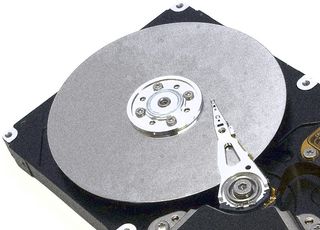TDK Finally Crams 2TB on One 3.5-inch HDD Platter
TDK has achieved 2 TB per 3.5-inch platter using its HAMR-based magnetic head technology.

Nearly one year ago, reports surfaced claiming that TDK had developed a technique that would cram 1 TB of data onto one hard drive platter. The company said it redesigned the magnetic read/write head of a hard drive by changing some of the materials and redesigning its overall structure to expand the recording density. The head also featured a special laser that heated up a high-coercive platter's hard surface with a precision of a few dozen nanometers.
This method of data storage is called heat-assisted magnetic recording, or HAMR, and was originally developed by Fujitsu back in 2006. By using this method, TDK achieved a BER of 10-2 with an areal density of 1 Tbit per square inch. That meant a 2.5-inch drive could theoretically store up to 2 TB of data.
At the time, TDK claimed that its new tech would go commercial as early as this year. There was even speculation that the industry would see 2 TB platters within the next 12 months. Tech-On reports that TDK has indeed reached this goal, and that it will use the new technology for volume production within 2014.
According to the report, TDK has achieved an areal density of 1.5 Tbits per square inch using a "magnetic head technology that is based on a thermal assist recording method and uses near-field light." That areal density is the equivalent to 1 TB per platter for 2.5-inch HDDs and 2 TB per platter for 3.5-inch HDDs, TDK said on Tuesday.
TDK verified the new areal density by using a "spin plate" rather than a working drive. A BER of 10-2 was confirmed by a linear density of 1,350kBPI and a track density of 1,113kTPI. The company then confirmed 1 Tbit per square inch technology with a linear density of 1,100kBPI and a track density of 915kTPI.
TDK told Tech-On that the actual results will be revealed at CREATEC JAPAN 2012 as the company showcases a prototype hard drive featuring the HAMR-based magnetic head.
Contact Us for News Tips, Corrections and Feedback
Stay On the Cutting Edge: Get the Tom's Hardware Newsletter
Get Tom's Hardware's best news and in-depth reviews, straight to your inbox.
-
hannibal It allso means that SSD are getting much further behind in storage capasity. But speed is the area of SSD in anyway so not a big problem.Reply
Maybe in 2014 we can get desent 500 GB SSD as an boot drive and 8 terabyte four platter HD as an storage... Not bad at all!
-
nforce4max This HAMR scares the crap out of anyone who specializes in data recovery and companies that do data recovery are having a difficult time as it is with keeping up with the pace of newer but less durable tech. At least there is a new kit that allows for data recovery for SSD without the need for the controller to be functional.Reply -
bison88 I imagine it'll worry people as much as read/write endurance did with SSD's when HAMR first goes live mainstream, but with all technology the first couple generations will always be more of "Beta" or "Prototypes" than a fully finalize product. HAMR will be with us for a long time to come, some estimates are putting it at 20 years for just HAMR alone to tap out and then still even further with HAMR + BPR to achieve past the 60TB 10Tb/inch2 arena.Reply
The skill level will go up, but I have faith as the industry constantly shows, that the kinks will be worked out. Early adopters will always run the biggest risk with any new technology, but if not for them driving the market and being the beta testers, we might never see new tech come out. -
f-14 still not what Dr.Evil was getting at when he wanted his sharks to have a nice hot meal, but this is good also and should net virtucom 1 MILLION Dollars muwhahahahahahahahahahahahahahahahaha-ahahahahahahahahahahahahahahahhaaaaaa-ahahahaaahahahahahahahahahahahahahahahaahaha-ahaah-aha.................ahahaa hahaaaa..........riiiiiight.... okay then.Reply -
ricdiculus Man, I didn't know TDK was even still around! Whats next, Maxell hard drives? I gotta get out more often.Reply -
shloader To bad TDK rarely makes hard drives if at all. Think they're just an R&D company. ok. So sell the tech to Western Digital who will push out a five platter monster through their recently acquired Hitachi Global Storage Technologies who are already known for that and we can get a 10TB Drive already!Reply -
techcurious But TDK doesn't manufacture hard drives.. I would not want to buy the first TDK HDD, that is also using a very new tech to the whole industry.. even veteran HDD makers have trouble with new tech, let alone a first time player.. Other HDD makers are also developing HAMR. I know seagate has made great advances with HAMR as well.Reply -
master_chen Reply10425714 said:So sell the tech to Western Digital.
I don't want any "Blue/Green Caviar" garbage anymore.
Most Popular





